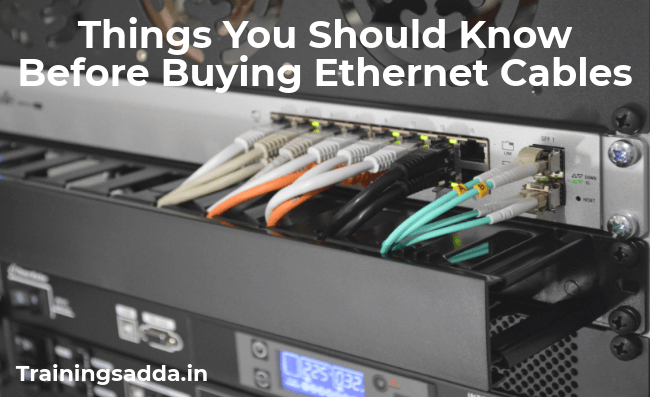Things You Should Know Before Buying Ethernet Cables

Last Updated on July 4, 2019 by admin
Ethernet cables are among the most ubiquitous types of computer and data cables. They’re used in network connections all over the place, making them a familiar sight in homes, offices, and other places. Being an integral part of the process, it is imperative that when you buy them, you need to get the right type of ethernet cable and the best possible.
Source: https://pixabay.com/photos/network-cables-rj45-patch-499792/
The issue is that not everyone knows enough about ethernet cables to make the right choices. Fortunately, these aren’t mysteries or corporate secrets. The information is easy to find, and we’ve summarized what you need to know here. With this, you’ll know the different types of ethernet cables and how to tell if you’re buying the right ones for your purposes.
Table of Contents
Specify the Type of Cable
Specifying the LAN cable you want or need is important. If you underspecify, you’re going to have impaired network performance. Signal strength and other network metrics are less powerful. If you overspecify the cable instead, you end up paying too much for power that you don’t actually put to its full use.
Why “Cat”?
Now, let’s get into why ethernet cables are labeled “cat.” The term is actually a branding of ethernet cable, and it’s one of the most important parts of making a purchase. These categories provide key information on the speed and frequency of the cable.
Read more: Important Tips When finding a Good Cable Manufacturer Online
Types of Cables
When buying cables, you want to get cat-5 or higher, and we’ll include a breakdown of each.
Cat-5 and Cat-5e
Cat-5 cables offer 100 Megabits per second. They operate at a frequency of 100Mhz. Cat-5e cables offer the same frequency, but also greater speed, clocking in at 1 Gigabit per second. Cat-5 is considered obsolete, though it still sees use in some contexts.
Cat-6 and Cat-6a
Cat-6 offer 10 Gigabits per second for speed, though with a caveat. Using the maximum capacity will shorten the length of the cable, forcing you to use 55 meters rather than a full 100 you’d get from other cables. They also have a frequency of 250 Mhz.
Cat-6a cables offer the same speed, but without a length-related restriction. The frequency is also changed, running at 500 Mhz. However, they are physically denser than Cat-6 and thus are less flexible. This can make it harder to work with.
Cat-7 and Cat-7a
Finally, there is Cat-7. These are the newest in available technology, with excellent transmissions speeds even at greater lengths. It can also support much higher bandwidth. They are more expensive than other types and require a GigaGate45 connector modified to connect to a standard Ethernet port. Cat-7a is the most expensive option and useful in certain settings, though it doesn’t offer much more transmission speed.
Read more: Ways in Which AR and VR Are Transforming Training in The Manufacturing Industry
Figuring out which would work best for your needs is simple. Run a speed test to gauge the connection speed. If your speed is 1mbps, there’s no need to get anything other than a Cat-5 ethernet cable. It covers most anything that’s consumer-level, though if you have a school or business, you’ll want faster and better cabling.
Shielding and Jackets
These cables also have their own protection. Some have shielding, while others use jackets.
Shielding
Shielding inside the cable is meant to protect against degradation of the signal, as well as block interference from the outside. These crop up in harsher environments, causing all sorts of problems. If you plan to run multiple cables together, having shielding is going to be important.
Read more: Fabulous Tips to Secure Your Netgear WiFi Network
Take note that Cat-5 and Cat-5e are both without shielding. Cat-6 can come in both shielded and unshielded variants. While this is unlikely to become relevant for consumer use, it could become useful if you intend to bundle them together for an office network setup.
Jackets
Jackets are what cover the body of the cable, making sure that everything remains undamaged while being laid down or routed around a home. The stronger the jacket, the better the integrity. This also allows it to last longer. Consumer-grade cables rely on PVC for protection but try not to get something with low-quality jackets. These break down faster than others, which means you’ll be replacing cables more often.

Other Questions
There are other questions you need to consider when buying ethernet cables, too. These are going to represent emergency cases, rather than anything that will occur due to regular use. Let’s consider a few questions about these unique circumstances.
Do you want burial cables that have protection from UV light? Are you going to be using these cables within a short distance of a power line? Are they installed along a wall? Do you need flame resistance?
Read more: Best Operating Systems For Ethical Hackers
These are questions that people don’t always ask when purchasing cables, even if they do take the time to consider if shielding and insulation. You aren’t going to need to ask yourself these questions under normal circumstances, but if the situation arises you’ll need the answers on-hand. Of course, these also affect the price of the cables.
Conclusion
Ethernet cables don’t seem very complicated. However, getting it right is important because there are so many factors related to performance and price. By knowing what you need and which cables are the best fit, you can get the most value out of your ethernet LAN cables .
Comments
0 comments

![How To Fix [pii_email_9adeb2eb81f173c673a5] Error Code?](https://www.trainingsadda.in/wp-content/uploads/2020/10/How-to-fix-pii_email_9adeb2eb81f173c673a5-Error-Code-390x220.png)


